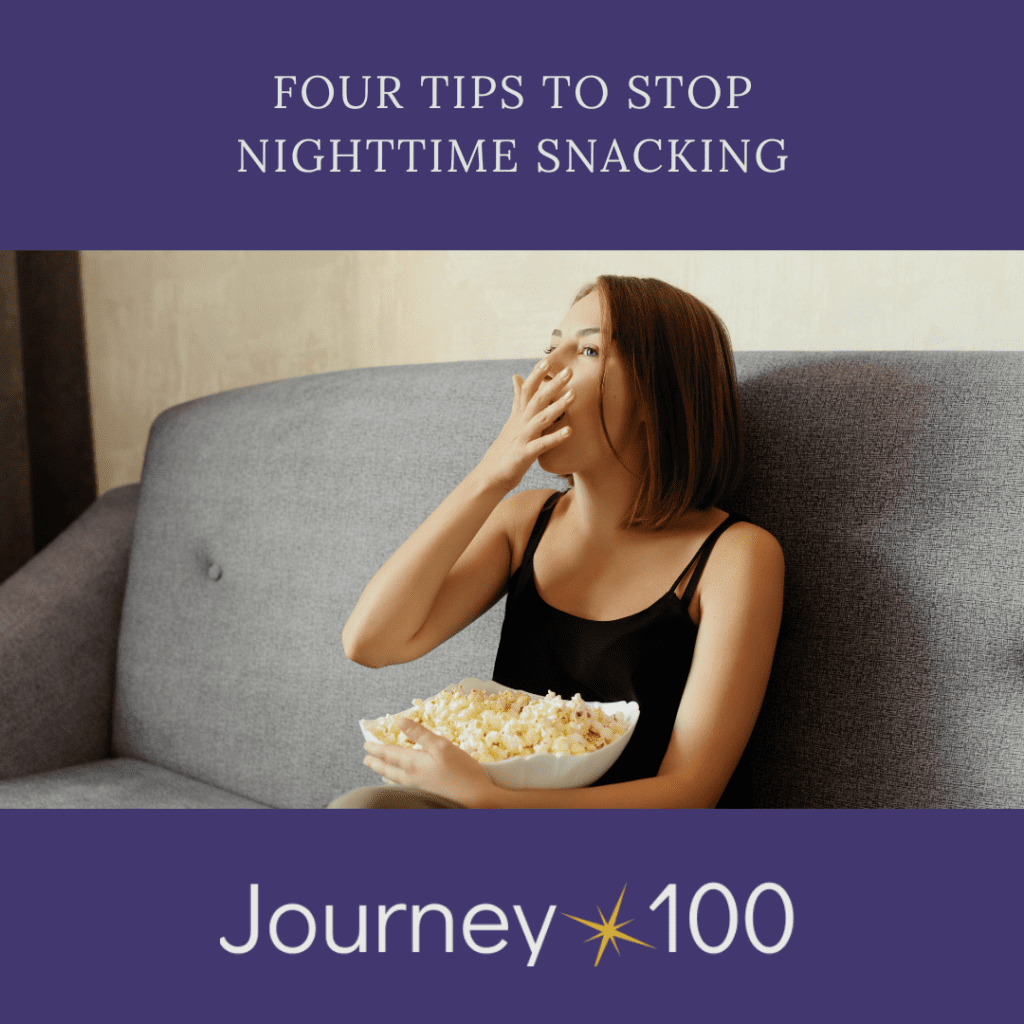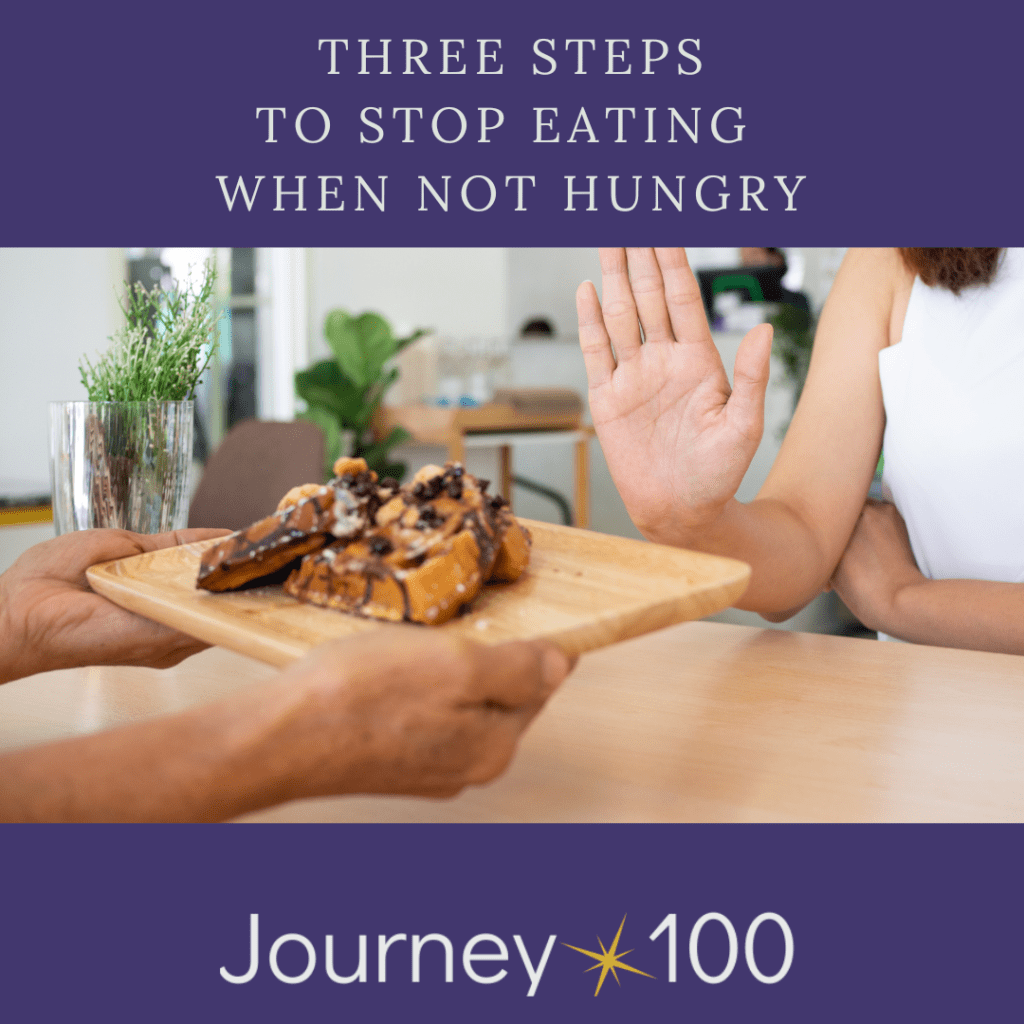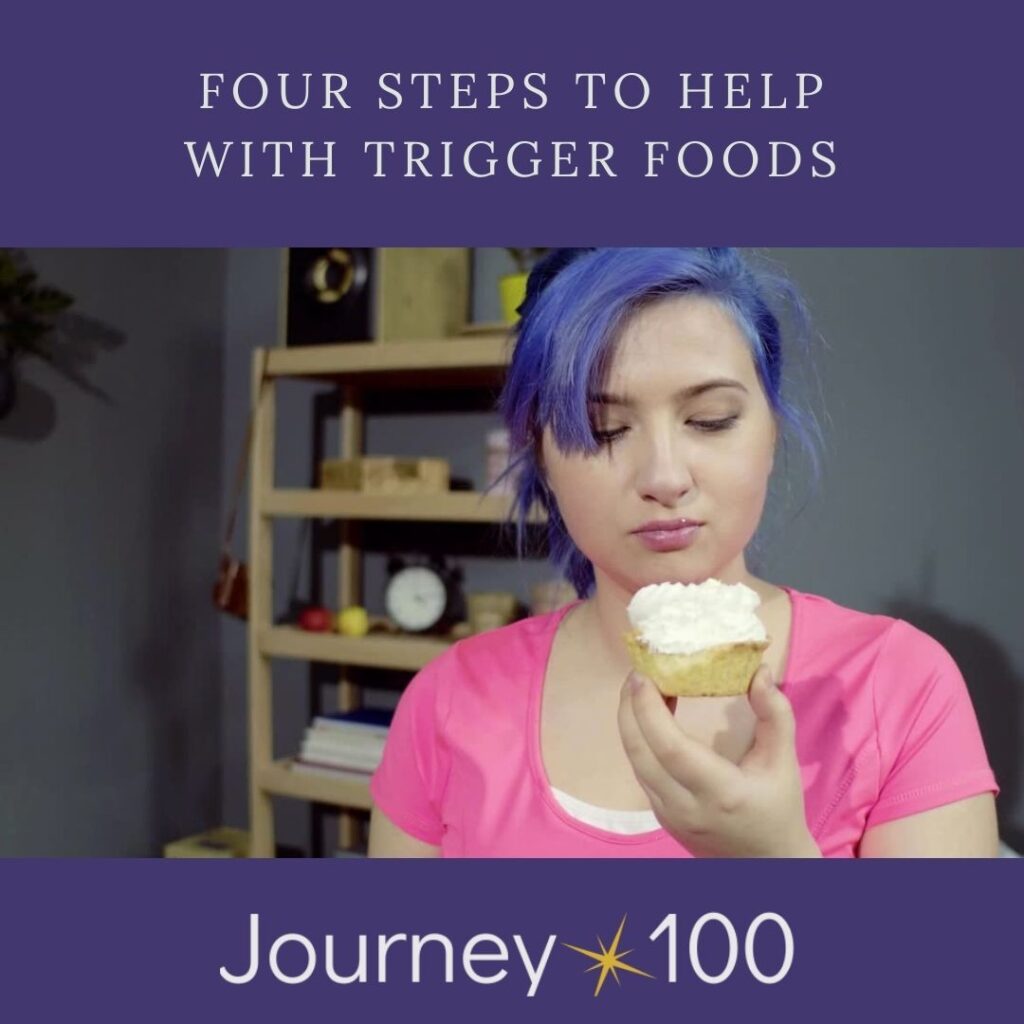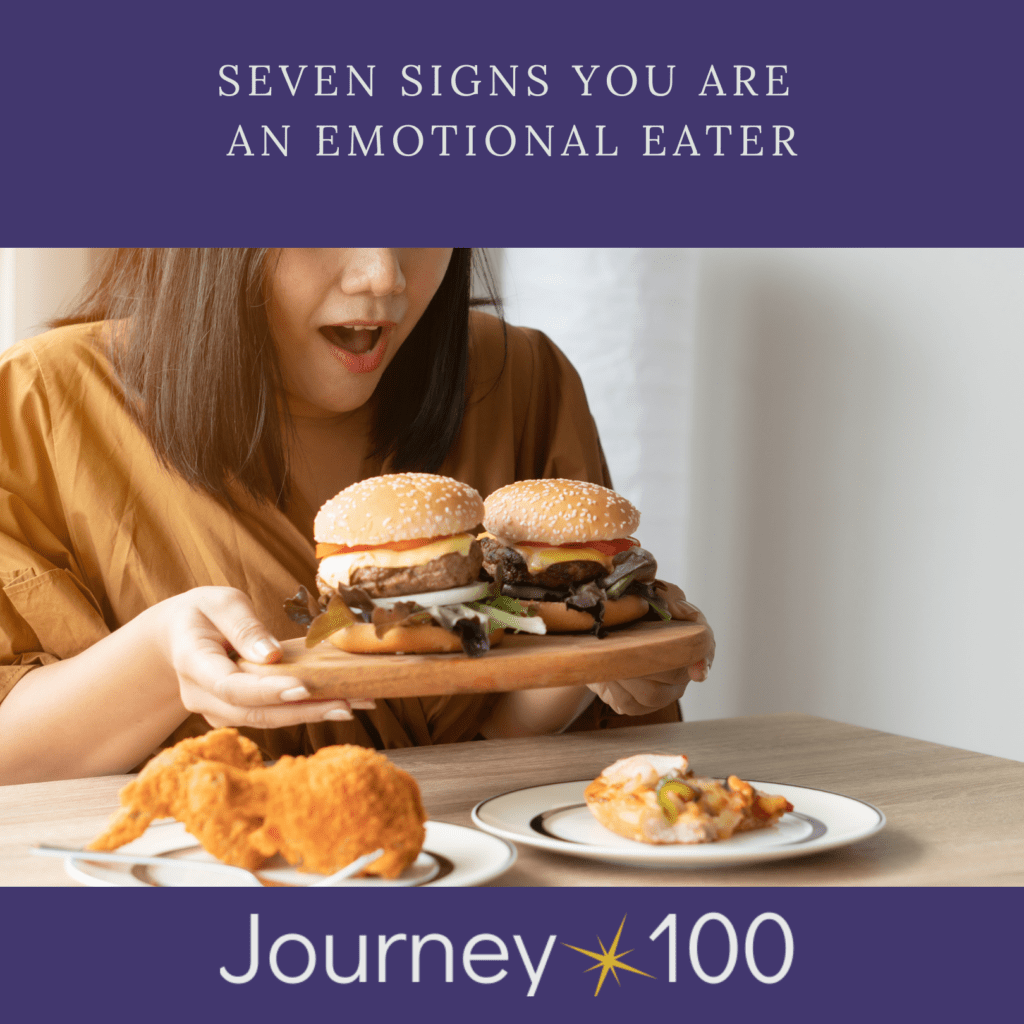Four tips to Stop Nighttime Snacking

So many women I work with are stay on plan breakfast and lunch but go off the rails in the evening. They succumb to nighttime snacking to unwind from the day but it also undoes their weight loss. Here you will learn four tips to stop nighttime snacking and consistently lose weight: Reconnect With Your Why Instead of focusing on stopping nighttime snacking, it is helpful to focus on what you want: lose weight! Before you snack, stop and think about why you want to lose weight. Do you want to be healthy for your kids? Feel better in your clothes? Have more energy? Remind yourself of your why. Picture how proud you’ll feel in the morning when you stick to your plan. Create a New Evening Habit A lot of nighttime snacking is just a habit. This is great news because habits can be formed and destroyed. It’s as easy as doing something else instead! It can be as easy as choosing to watch TV in a different chair to change your habit. You can also sip a cup of tea, take a warm bath, or write down three things you’re grateful for. Find something that feels good and helps you relax without food and before you know it, you’ll be getting closer to your weight loss goal. Out of sight, Out of mind Don’t leave snacks where you can easily see them. At the end of the day, you are often emotionally and physically drained. Seeing crave-worthy foods is a recipe for caving-in. Often times, you don’t have the mental bandwidth to tell yourself no. Put snacks in hard-to-see places or don’t buy them at all. Instead, keep healthy options around like veggies, fruit, or yogurt if you really need something to eat. Set a Kitchen Curfew The final tip is to pick a time when the kitchen “closes” for the night. Wipe the counters down and start the dishwasher. If you need to, put a chair in the doorway to keep you out. After that, brush your teeth or chew gum. It’s a simple way to remind yourself that eating is done for the day. Remember nighttime snacking is just a habit. Just something you’re used to doing. And it can be changed. You won’t cut nighttime snacking in one try. Try one or all of these tips to stop nighttime snacking and before you know it, it will be a thing of the past. Be patient with yourself and celebrate all your wins! And remind yourself that you are evolving into that future version of yourself that is living and loving her goal weight life! You’ve got this! Your Coach, Andrea
Three steps to stop eating when not hungry

Eating when you are not hungry equals weight gain. And if you are on a weight loss journey that is a recipe for disaster! But how do you stop eating when you aren’t hungry? Follow these three steps to get back in tune with your body and stop eating when you aren’t hungry: Step One: Identify your hunger signs The first step to stop eating when you are not hungry is to figure out if you really are hungry. For many women this can actually be quite difficult. You’ve spent years eating by the clock, eating to relieve stress or eating because it simply feels good. To determine if you are physically hungry, drop into your body. What does that look like? Close your eyes. Ask yourself where do I feel hungry? For me, I know I am truly hungry when the middle of my abdomen feels a little tight. I also get slight growls in my stomach. If I have been truly hungry for a bit then the hunger starts appearing in the front of my head as a slight headache and I will feel my energy levels begin to dip. On the other hand, these physical sensations are not present when I am not hungry. Instead I will find myself “tasting” food in my mouth, like daydreaming about how good a Reese’s peanut butter cup would be right now. Sometimes when I am not hungry but WANT to eat, I will ask myself “Am I hungry?” and then soon enough I will feel a little tingle in my stomach. This is phantom hunger. It’s like a little ghost of hunger that comes pretty quickly after I get a craving for something. This isn’t true hunger. How do I know? Go to step two. Step Two: Take an inventory of your circumstance When I find myself wanting to eat when I’m not physically hungry, I take a moment to figure out what is going on in my life. One great way to do this is ask yourself “If I wasn’t going to eat right now, what would I be doing?” So often that 3pm hunger is actually being tired of work and not wanting to start another work task. In the evenings, I would be left alone with my thoughts about what I screwed up during the day, what’s left to be done tomorrow or thoughts of how I’m so exhausted and nothing really feels good in my life. Other times, I am just plain bored and want to be entertained! Once you figure out if you want to eat to avoid something in your life, then solve for that. If I am tired of work and don’t want to start another work task, then I take a 15-minute break and go for a walk, meditate or watch a couple silly tiktok videos (be sure to set a timer and don’t go beyond the 15 minutes!). If I’ve put the kids to bed and I don’t want to be left alone with my troubling thoughts, I break out my journal, jot down a quick to-do list for the next day, tell myself I’m a good wife and mother, then give myself permission to rest and relax. If I want to be entertained, then I snuggle in a blanket and watch my favorite show. Understanding what you truly need in that moment will help you understand and care for yourself better. When you start solving for what is actually bothering you, the less you will feel driven to eat at times when you are not hungry. If you’ve identified the non-food reason you want to eat when you aren’t hungry but still feel compelled to eat, continue to step three. Step Three: Do a hard reset Our brains present persistent thoughts of wanting to eat when we are not hungry simply because it is trying to avoid something in our life (see step two) AND there is not much else for it to do. On my weight loss journey, I found that continuing to push through and simply NOT eat was difficult. This was especially the case when I started working from home during COVID. I worked in the living room and thoughts about what was in the fridge started popping into my head. I’d ask myself “What would I be doing if I wasn’t eating” and the answer would generally be doing a work task. So I would acknowledge I didn’t want to do the work task, take a little break and then start the task anyway. But the thoughts kept coming. In those instances, I gave myself a protocol to help me reset. I would chug a giant glass of water, get outdoors for a five-minute walk and talk to myself. The magic in the reset is creating different sensations for yourself. The glass of water will help your body feel different on the inside (fuller and maybe colder). Getting outdoors will help you feel different on the outside (sun on your skin, wind on your face, maybe it’s warmer or cooler than your home). Finally talking to yourself. Be very specific in the things you say. This is a time to speak to yourself kindly and cheer yourself on. I often say “I’m so proud that I took this time to reset. I’m so glad that I am choosing my bigger goal over something I want in this moment. This is what self care looks like and I’m so happy I made this choice.” Final reminder: Even if you eat when you are not hungry, remember that it will never help to be unkind or berate yourself. Your weight loss journey will never be a straight line to your goal weight. Be open to learning when things don’t go as expected. If you are learning then you are always moving forward with better knowledge for the future. If you struggle with eating when you are not hungry, I can help. Schedule
Four steps to help with trigger foods

Trigger foods. Foods you can’t resist. They call out to you and beg you to eat them. Generally, these foods are not carrots, broccoli or apples. They are decadent foods. Often foods that you are forbidden because they are “bad foods” or unhealthy. You probably feel out of control around these foods and blame them for any weight gain. Never fear! If you need help with trigger foods, this post is for you. Here are four step for handling trigger foods like a boss: 1. Quit calling it a trigger food Seems simple right? But every time you call ice cream or chips your trigger food, you give all of your power away to it. It becomes a dramatic story of how this food is the downfall of your weight loss. You are powerless around it and must indulge. Calling it a trigger food puts you and your weight loss at an extreme disadvantage. Many people will tell you that they can’t keep certain foods in the house. And while this is good intentioned that doesn’t mean you will never come face to face with that food. Continuing to have this story in your mind guarantees anxiety, worry, and fearfulness about when you might come face to face with that food. It can also lead to binging on these foods when you finally get the chance because they have become forbidden even though your desire for them is high. Instead of calling them your trigger food, change the story to something more boring, like “It’s just a food you like to eat.” 2. Calm your brain down Our brains have been designed to keep us safe. Back in the times of cavewomen, this meant being able to identify ALL the problems around us that could cause us harm. Life today does not require our brains to find the mountain lion or the poisonous berries. But our brain still wants to do what it was designed to do: FIND ALL THE PROBLEMS. And guess what, your trigger food has been identified as a problem. And that’s OK. Not every problem our brain identifies is a true problem. Nor is every problem our brain identifies a reason to take action. Your brain might tell you things like: “Oh my god, there goes my diet!” “I can never lose weight and have a social life too!” “I will never be able to resist those!” “I can never stop eating….” All of those are just thoughts. Thoughts that are completely optional. Currently those thoughts are full of drama and doom. Calm your brain down by making the story boring. Remember, this isn’t a trigger food. This is just a food I enjoy eating. It can also be helpful to recognize other things you enjoy doing but are able to practice restraint around. I love going for walks on beautiful days but somehow I still manage to go to work and earn a living on beautiful days. I love spending money on cute clothes and yet each month I make sure enough remains in my account to pay the mortgage and utilities. I’m sure you have similar examples in your life. Don’t take what your brain presents you as the truth. Ask yourself if your brain is being dramatic and if you have evidence that the opposite is true as well. 3. Visualize how you want to eat them Now this isn’t a lusty visualization practice. The purpose isn’t to create more desire for the food by imagining how amazing it tastes. This visualization is to practice being around these trigger foods and imagining yourself being in control and intentional about how you eat them. My clients often feel burdened and powerless around these trigger foods. So I ask them to imagine what it would look like to be in control around them. Imagine yourself having your trigger food in your pantry. Visualize yourself going into the pantry for other things and never reaching for that food. Imagine yourself being unaffected that it is sitting there. Another visualization you can do is enjoying the trigger food. Watch yourself plate it, eat half of it and then throwing the rest out. If that causes you some anxiety, remind yourself that you are able to buy more at any time. This food is always available to you. Reminding yourself this can provide comfort that no matter what you are in charge and able to obtain that food whenever you want. It helps take away the scarcity and urgency away from that food. 4. Practice being around them Once you spend time visualizing yourself around these trigger foods, you can practice being around them in real life. Before you do, use that brain for what it was designed for! Ask it what problems might come up that could derail you from showing up as you visualized. Maybe you won’t want to stop eating it. Perhaps you eat the entire box of them. After identifying the potential problems, come up with a game plan. Maybe you start with two cookies on a plate and put the package away. Or you serve some chips and dip and then relocate to another room to enjoy them. Whatever you think might help you stick with your plan that you visualized. Then go for it! Remember, perfection is not a requirement and it is likely that you might have some overeats or completely ignore the plan all together. That’s OK. Progress has already been made by thinking it through beforehand and you’ll get more and more skilled at being around your trigger foods the more you practice. What trigger food will you practice with? Your Coach, Andrea
Seven signs that you are an emotional eater

Emotional eating is the enemy of weight loss. It is very easy to identify emotional eating when it presents itself exactly how we see it in the movies: woman gets dumped and she sobs into a pint of Ben and Jerry’s. But that’s not the only way emotional eating presents itself. Here are seven signs that you are an emotional eater: 1. Hunger and urges come on strong and quickly The act of digestion in the human body is a gradual process. You consume food and (depending on how much you ate) over the next few hours the body goes to work digesting. Hunger starts gradually as the stomach is mostly empty and gets more intense as it remains empty. True biological hunger can even come and go as the call for food remains unanswered. Emotional hunger is just the opposite. It is strong and intense. You may feel powerless against the call for the chocolate chip cookies after dinner or the bag of chips mid-afternoon. Sudden and intense urges for certain foods are a sure sign of emotional eating. 2. You struggle with snacking at certain times of the day If you have certain times of the day when you are drawn to eat, this is emotional eating. Most often my clients report the 3-5pm or after dinner timeframe to be the most problematic for unwanted or emotional eating. This is prime time for the stress of your day to have built up and leave you searching for some relief in the form of food. Even if you are eating because it is a certain time of day, this is emotional eating. Eating because it is 9am and “breakfast” time is emotional eating if at that time you aren’t experiencing true hunger. Which bring us to the next sign: 3. You eat when you aren’t hungry If you aren’t hungry and you choose to eat, you are emotionally eating. Has anyone ever asked if you were ready to eat dinner and you answered “I could eat?” Chances are you weren’t hungry but could fit some extra food into your stomach so yeah “I could eat.” Eating at times when our body isn’t physically asking us for food means that we are eating to our emotions. It could be boredom, stress, connectedness, relief, entertainment, happiness, etc. Connectedness is a BIG one. Many of us choose to eat so we feel connected to those around us. We don’t want to sit at a meal, party, gathering and be the only person not eating. That’s emotional eating. 4. You get excited about eating every time you eat Food can be an exciting and pleasurable part of our lives. However, if you are routinely excited and can’t wait to eat, you are eating emotionally. Many of my clients are high achieving women who lean more into business than play. They are constantly working hard and achieving big goals that food becomes one of the only constant joys in their life. They use food as a reward because it is widely socially acceptable and necessary to live. It’s an activity that they must do anyway while every other minute of their day is spent working and serving those around them. Even if you are not a high achieving woman, take note of what felt good to you throughout your day. If you can’t think of anything other than that delicious slice of cheesecake you had after dinner, chances are you are emotionally eating in the very same way. 5. You use eating to delay doing other things There is no doubt that your to-do list is as long as the day is long. Works tasks, household chores, scheduling meetings/appointments, car maintenance, calling the utility company…the list could literally go on forever. Especially when COVID-19 hit the U.S., I found myself curiously wandering into the kitchen to find a snack throughout my work day. At first, I was frustrated until I began to see a pattern. Every time I received an email from my boss giving me another assignment or I was about to start a project that I was dreading or unsure of how to complete, the urge to check the fridge came over me. The amazing thing is that as I became aware of my action and the reason behind it, I was able to make lasting changes to that behavior. Now when I get that urge to hit the kitchen during the workday, I ask myself some important questions: What am I really hungry for? If I wasn’t going to grab a snack, what would I be doing? What can I do to mentally prepare for my next task? 6. You feel out of control around food Once you start, you just can’t stop. If that is your mantra around certain foods, this is your wake up call that you are emotionally eating. Feeling compelled to eat something or to eat something until it’s completely gone is driven by your emotions. Feeling compelled or driven are emotions. Often times you are eating past the point of giving your body the amount of food that it needs and therefore the desire and urge to eat is not driven by your physical need but rather your emotional needs. 7. You have trouble losing weight For many of us, tracking calories and following a certain diet works until we quit following them. We are able to play by the rules until the rules become too much of a burden on how we live our lives. Frustration, resentment, boredom and plain ol’ don’t wanna creep in and overtake our resolve to lose the weight. We are able to lose the weight until our emotions overtake us and we decide that we want to eat whatever we want more than losing our excess weight. That’s why addressing your emotional state is the best way to navigate weight loss. You can solve for what you are truly needing in that moment and leave the food for nourishing
